It is impossible to imagine an active and healthy lifestyle without exercise. Joints are the most important element of the musculoskeletal system, allowing a person to move freely and feel full. With age, dystrophic changes occur in bone and cartilage tissues, painful sensations appear, which are a sign of the onset of the disease.
The femoral joint can withstand enormous load throughout life, so it is not surprising that the most common pathology of ODA is hip arthrosis - arthritis. In this article you will learn what it is, as well as the causes, consequences and methods of treating coxarthrosis.
Characteristic Characteristics and Causes of Occurrence
Coxarthrosis is a chronic inflammatory process of the hip joint in which cartilage tissue undergoes premature destruction.
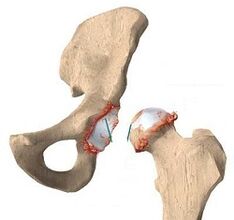
The development of the disease leads to the growth of osteophytes and the fusion of the acetabular and femoral heads, which narrows the joint space, the joint loses its functionality.
Explain that coxarthrosis is the same as osteoarthritis and osteoarthritis of the pelvis.
The disease can arise as a primary pathology or develop against the background of existing diseases.
Consider the main causes of coxarthrosis:
- during active or excessive physical activity (trauma, microtrauma, overload);
- Congenital anomalies (dysplasia, Perthes disease, primary joint deformity);
- Inflammation of the pelvis (ankylosing spondylitis, rheumatoid or psoriatic arthritis);
- Acute stress (vascular and muscle spasm, aseptic necrosis, hypothermia);
- hormonal disorders;
- ischemic heart disease;
- Diseases of the endocrine system (obesity, diabetes).
A complex of health problems leads to the development of coxarthrosis. Most often, the disease is diagnosed in middle-aged and elderly people, however, in the presence of several provocative factors at the same time, young people and even children are susceptible to coxarthrosis.
Symptoms
In order to respond in a timely manner to the development of pathology, it is important to note the characteristic symptoms that change with the progression of osteoarthritis.
The first and most important symptom is pain in the leg that reaches the groin, gluteal muscles, groin, thigh and knee. The pain increases after physical exertion, prolonging the standing and sitting position.
important! At first, the pain may be small and not appear at all in the pelvis, but, for example, in the knee. This fact complicates early diagnosis and correct diagnosis.
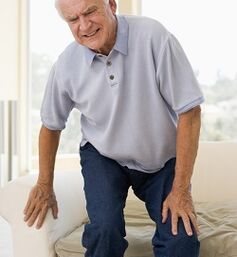
If the disease is not diagnosed in time, the patient will experience symptoms of osteoarthritis of the hip joint, such as:
- Severe pain in the abdomen while walking or resting;
- painful, rough cristles when moving to the side of the thigh and while walking (should not be confused with pressing, which accompanies most healthy people);
- Stiffness of the joints, restriction of leg mobility;
- change of gait, lameness, duck gait;
- shortening or lengthening of the limb;
- muscle atrophy;
- Fixation of the leg in one position (ankylosis).
An important diagnostic sign of coxarthrosis is the physical limitations of leaning forward, grabbing the side of the thigh.
A patient with this diagnosis has difficulty tying the soles of their shoes, stretching their legs, and sitting deeply.
There are 3 degrees of osteoarthritis of the acetabular and femoral head, characterized by gradual destruction of the joint. Let’s discuss their features below.
Stage 1 of coxarthrosis is characterized by a small destruction of cartilage, the joint space is slightly narrowed.In the second stage, the destruction of cartilage tissue increases significantly, the first signs of the disease begin to break down: pain, stiffness.
More serious damage to the hip joint occurs in 3 stages. It is characterized by deep destruction of cartilage, bone deformation, pain at rest. The disease completely destroys the cartilage and deforms the femur.
The joint loses mobility, the leg is fixed and completes the support. In this case, conservative therapy is powerless; Surgical treatment with joint replacement is required.
Diagnostics
Diagnosis of the disease shows how badly the cartilage works and whether there is a cure for osteoarthritis of the hip joint.
The success of therapy depends on when treatment was started.
Note. The last stage of coxarthrosis does not respond to conservative therapy and requires surgical intervention. Diagnosis and treatment of the disease at an early stage of the disease increases the chances of recovery.
To make a diagnosis, an external examination is performed to assess the degree of mobility of the hip joint, gait and changes in leg length. X-ray, CT and MRI are prescribed to confirm primary coxarthrosis. If the patient needs surgical treatment, additional urine, stool, blood, and joint fluid are taken.
Treatment of the disease
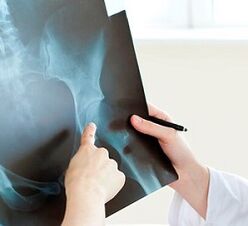
Coxarthrosis is a progressive disease. It is impossible to cure it once, like acute respiratory infections, and forget about the condition of your joints.
Successful treatment of grade 1, 2, and 3 hip arthrosis requires an integrated approach that combines healing exercises, medications, physiotherapy, and lifestyle changes.
In extreme cases, the patient will need surgical treatment for coxarthrosis. The method of therapy depends on the degree of the disease.
Medications
The first thing a patient diagnosed with osteoarthritis is prescribed with nonsteroidal anti-inflammatory drugs. They act directly on the site of inflammation and provide symptomatic treatment.
Vasodilators are prescribed to treat coxarthrosis. They are necessary to increase blood circulation to the diseased joint, to enhance cartilage nutrition.Note! It is important to follow the dosage and duration of the course prescribed by your doctor. Uncontrolled use of nonsteroidal anti-inflammatory drugs causes side effects.
Chondroprotectors are used to restore cartilage tissue and joint mobility. Glucosamine and chondroitin sulfate are substances that stimulate the formation of new building cells and inhibit the action of enzymes that destroy cartilage tissue.
massage
Manual therapy or rehabilitation massage is passive gymnastics for the affected joints. Massage movements improve blood circulation and lymphatic drainage, strengthen muscles, and make tendons and tendons more elastic. This approach to treatment helps reduce pain, enhance the effect of drug therapy, and reduce the need for medication.
important! Massage should be performed only by a qualified professional. Careless movements will cause even more pain and joint damage.
Physiotherapy exercises
Movement is the basis of life. In osteoarthritis of the hip bones gymnastics aims to nourish the cartilage and restore joint mobility, strengthen the muscular corset.
Regular performance of gymnastic exercises reduces the discomfort in the legs while walking.
Gymnastics allows you to treat hip pain at home.
All movements are aimed at treating and preventing stages 1 and 2 of osteoarthritis of the hip joints.
Before you start exercising, make sure there are no contraindications to exercise:
- hypertension;
- critical days;
- Infectious diseases;
- increased body temperature;
- Recovery period after surgery on the abdomen and chest organs;
- inguinal and umbilical hernia;
- hernia of the intervertebral discs;
- Acute inflammatory processes of internal organs or exacerbation of chronic diseases;
- Severe diseases of the cardiovascular and circulatory systems.
If any movement during exercise causes severe pain, most likely you will not like it, so it is best not to do it and exclude it from the complex.
diet
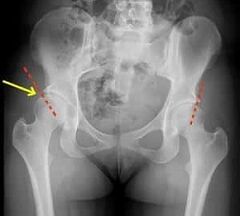
Diet therapy for hip arthrosis aims to reduce and maintain a normal weight.
Excess weight increases the load on the spine and joints, which creates an additional risk of diseases of the musculoskeletal system.
The basis of the diet is a moderate intake of foods rich in vitamins and minerals. Food should be whole and contain the necessary building blocks of cells: proteins, carbohydrates, fats.
Plant foods are preferred: nuts, seeds, leafy vegetables, seasonal vegetables and fruits, lean meats and fish, medium-fat fermented dairy products, legumes and cereals.
Cow's milk is best taken in moderation.
Fatty, spicy, smoked, canned, fried, pickled dishes, semi-finished products, alcohol, coffee are excluded from the diet.
Bad habits (smoking, drug addiction, overeating) should also be eliminated from your lifestyle as they clog the body and make it prematurely aging.
How to get rid of pain with folk remedies
Homeopathy is one of the methods of alternative therapy for coxarthrosis of the hip joint. Based on natural components, homeopaths create medications designed to treat internal organ and human skeletal pathologies. The peculiarity of homeopathic remedies for osteoarthritis is that they can restore the balance between the destruction of cartilage by enzymes and the renewal of its tissues.
Attention! You should be diagnosed with the disease before starting hip treatment at home. It is important not to allow the pathology to worsen as this may cost the person the ability to walk.
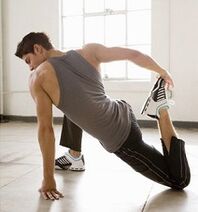
Homeopathic remedies, injections and ointments for the treatment of joints are selected according to the physical conditions of the environment and the location of the disease.
You should consult your doctor before using any medication!
Prevention
People prone to this pathology should avoid stress, injuries, timely treatment of infectious diseases, exercise regularly, eat well and get enough sleep.
If you have discomfort in your legs, it is recommended that you contact an orthopedist immediately for diagnosis and treatment.
Conclusion
Osteoarthritis of the femoral joints is most common in people over the age of 45, athletes and congenital pathologies of the limbs. The disease destroys and deforms the joint, the person experiences excruciating pain in the legs. Successful treatment of coxarthrosis requires therapeutic exercise, medication, patient lifestyle and weight correction, and manual therapy.Attention to health is the key to longevity of funds! Do not delay a visit to the orthopedist at the first symptoms of the disease.














































